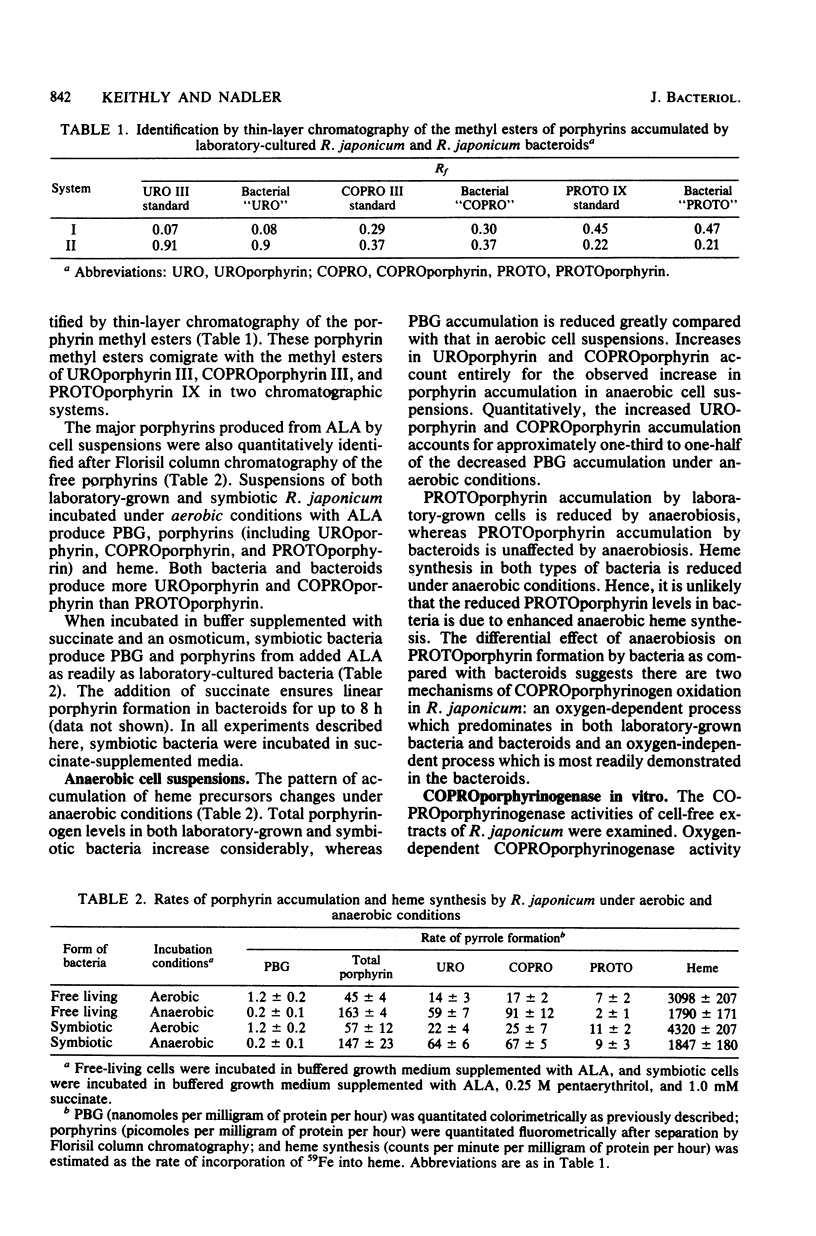Abstract
The obligately aerobic soybean root nodule bacterium Rhizobium japonicum produces large amounts of heme (iron protoporphyrin) only under low oxygen tensions, such as exist in the symbiotic root nodule. Aerobically incubated suspensions of both laboratory-cultured and symbiotic bacteria (bacteroids) metabolize delta-aminolevulinic acid to uroporphyrin, coproporphyrin, and protoporphyrin. Under anaerobic conditions, suspensions of laboratory-cultured bacteria form greatly reduced amounts of protoporphyrin from delta-aminolevulinic acid, whereas protoporphyrin formation by bacteroid suspensions is unaffected by anaerobiosis, suggesting that bacteroids form protoporphyrin under anaerobic conditions more readily than do free-living bacteria. Oxygen is the major terminal electron acceptor for coproporphyrinogen oxidation in cell-free extracts of both bacteroids and free-living bacteria. In the absence of oxygen, ATP, NADP, Mg2+, and L-methionine are required for protoporphyrin formation in vitro. In the presence of these supplements, coproporphyrinogenase activity under anaerobic conditions is 5 to 10% of that observed under aerobic conditions. Two mechanisms for coproporphyrinogen oxidation exist in R. japonicum: an oxygen-dependent process and an anaerobic oxidation in which electrons are transferred to NADP. The significance of these findings with regard to heme biosynthesis in the microaerophilic soybean root nodule is discussed.
Full text
PDF







Selected References
These references are in PubMed. This may not be the complete list of references from this article.
- APPLEBY C. A. The oxygen equilibrium of leghemoglobin. Biochim Biophys Acta. 1962 Jul 2;60:226–235. doi: 10.1016/0006-3002(62)90398-0. [DOI] [PubMed] [Google Scholar]
- Avissar Y. J., Nadler K. D. Stimulation of tetrapyrrole formation in Rhizobium japonicum by restricted aeration. J Bacteriol. 1978 Sep;135(3):782–789. doi: 10.1128/jb.135.3.782-789.1978. [DOI] [PMC free article] [PubMed] [Google Scholar]
- Bergersen F. J., Turner G. L., Appleby C. A. Studies of the physiological role of leghaemoglobin in soybean root nodules. Biochim Biophys Acta. 1973 Jan 18;292(1):271–282. doi: 10.1016/0005-2728(73)90271-5. [DOI] [PubMed] [Google Scholar]
- Bergersen F. J., Turner G. L. The role of O2-limitation in control of nitrogenase in continuous cultures of Rhizobrium sp. Biochem Biophys Res Commun. 1976 Nov 22;73(2):524–531. doi: 10.1016/0006-291x(76)90738-5. [DOI] [PubMed] [Google Scholar]
- Bradford M. M. A rapid and sensitive method for the quantitation of microgram quantities of protein utilizing the principle of protein-dye binding. Anal Biochem. 1976 May 7;72:248–254. doi: 10.1006/abio.1976.9999. [DOI] [PubMed] [Google Scholar]
- Cutting J. A., Schulman H. M. The biogenesis of leghemoglobin. The determinant in the Rhizobium-legume symbiosis for leghemoglobin specificity. Biochim Biophys Acta. 1971 Jan 19;229(1):58–62. [PubMed] [Google Scholar]
- Cutting J. A., Schulman H. M. The site of heme synthesis in soybean root nodules. Biochim Biophys Acta. 1969 Dec 30;192(3):486–493. doi: 10.1016/0304-4165(69)90398-5. [DOI] [PubMed] [Google Scholar]
- Dailey H. A., Jr, Lascelles J. Reduction of iron and synthesis of protoheme by Spirillum itersonii and other organisms. J Bacteriol. 1977 Feb;129(2):815–820. doi: 10.1128/jb.129.2.815-820.1977. [DOI] [PMC free article] [PubMed] [Google Scholar]
- Dilworth M. J. The plant as the genetic determinant of leghaemoglobin production in the legume root nodule. Biochim Biophys Acta. 1969 Jul 30;184(2):432–441. doi: 10.1016/0304-4165(69)90047-6. [DOI] [PubMed] [Google Scholar]
- Godfrey C. A., Dilworth M. J. Haem biosynthesis from ( 14 C)- -aminolaevulinic acid in laboratory-grown and root nodule Rhizobium lupini. J Gen Microbiol. 1971 Dec;69(3):385–390. doi: 10.1099/00221287-69-3-385. [DOI] [PubMed] [Google Scholar]
- Jacobs N. J., Jacobs J. M., Brent P. Characterization of the late steps of microbial heme synthesis: conversion of coproporphyrinogen to protoporphyrin. J Bacteriol. 1971 Jul;107(1):203–209. doi: 10.1128/jb.107.1.203-209.1971. [DOI] [PMC free article] [PubMed] [Google Scholar]
- Jacobs N. J., Jacobs J. M., Brent P. Formation of protoporphyrin from coproporphyrinogen in extracts of various bacteria. J Bacteriol. 1970 May;102(2):398–403. doi: 10.1128/jb.102.2.398-403.1970. [DOI] [PMC free article] [PubMed] [Google Scholar]
- Jacobs N. J., Jacobs J. M. Microbial oxidation of protoporhydrinogen, an intermediate in heme and chlorphyll biosynthesis. Arch Biochem Biophys. 1979 Oct 15;197(2):396–403. doi: 10.1016/0003-9861(79)90261-3. [DOI] [PubMed] [Google Scholar]
- MAUZERALL D., GRANICK S. The occurrence and determination of delta-amino-levulinic acid and porphobilinogen in urine. J Biol Chem. 1956 Mar;219(1):435–446. [PubMed] [Google Scholar]
- MacKenzie C. R., Vail W. J., Jordan D. C. Ultrastructure of free-living and nitrogen-fixing forms of Rhizobium meliloti as revealed by freeze-etching. J Bacteriol. 1973 Jan;113(1):387–393. doi: 10.1128/jb.113.1.387-393.1973. [DOI] [PMC free article] [PubMed] [Google Scholar]
- Mori M., Sano S. Protoporphyrin formation from coproporphyrinogen III by Chromatium cell extracts. Biochem Biophys Res Commun. 1968 Aug 21;32(4):610–615. doi: 10.1016/0006-291x(68)90281-7. [DOI] [PubMed] [Google Scholar]
- Poulson R., Polglase W. J. Aerobic and anaerobic coproporphyrinogenase activities in extracts from Saccharomyces cerevisiae. J Biol Chem. 1974 Oct 25;249(20):6367–6371. [PubMed] [Google Scholar]
- Poulson R., Polglase W. J. The enzymic conversion of protoporphyrinogen IX to protoporphyrin IX. Protoporphyrinogen oxidase activity in mitochondrial extracts of Saccharomyces cerevisiae. J Biol Chem. 1975 Feb 25;250(4):1269–1274. [PubMed] [Google Scholar]
- SANO S., GRANICK S. Mitochondrial coproporphyrinogen oxidase and protoporphyrin formation. J Biol Chem. 1961 Apr;236:1173–1180. [PubMed] [Google Scholar]
- Sutton W. D., Jepsen N. M., Shaw B. D. Changes in the Number, Viability, and Amino-acid-incorporating Activity of Rhizobium Bacteroids during Lupin Nodule Development. Plant Physiol. 1977 Apr;59(4):741–744. doi: 10.1104/pp.59.4.741. [DOI] [PMC free article] [PubMed] [Google Scholar]
- Tait G. H. Coproporphyrinogenase activities in extracts of Rhodopseudomonas spheroides and Chromatium strain D. Biochem J. 1972 Aug;128(5):1159–1169. doi: 10.1042/bj1281159. [DOI] [PMC free article] [PubMed] [Google Scholar]
- Verma D. P., Nash D. T., Schulman H. M. Isolation and in vitro translation of soybean leghaemoglobin mRNA. Nature. 1974 Sep 6;251(5470):74–77. doi: 10.1038/251074a0. [DOI] [PubMed] [Google Scholar]
- Wittenberg J. B. The molecular mechanism of hemoglobin-facilitated oxygen diffusion. J Biol Chem. 1966 Jan 10;241(1):104–114. [PubMed] [Google Scholar]


